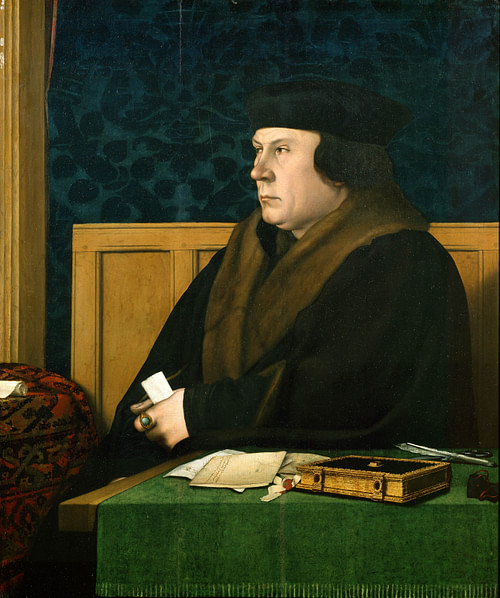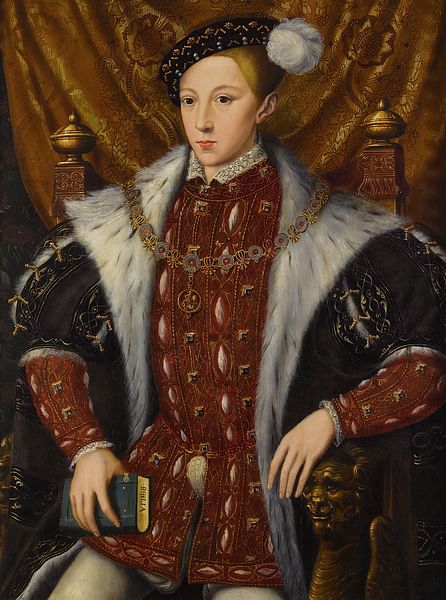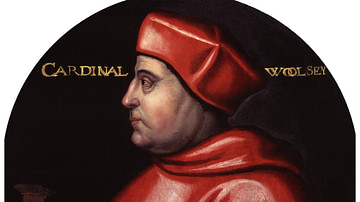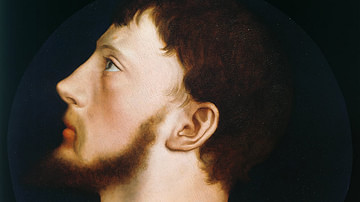
The English Reformation began with Henry VIII of England (r. 1509-1547 CE) and continued in stages over the rest of the 16th century CE. The process witnessed the break away from the Catholic Church headed by the Pope in Rome. The Protestant Church of England was thus established and the English monarch became its supreme head. Other consequences included the dissolution of the monasteries, the abolition of the Mass, the use of the English language in services and in the Bible used, the replacement of altars with communion tables, and a general doing away of the more decorative and showy elements of Catholicism both within services and the churches themselves. The majority of people went along with the change, the rich because of the wealth they gained from the stripped-down Church, and the commoners because they deferred to the authorities and imposition of fines for not toeing the line and attending the new Anglican Church, as it became known. There were, too, objections from both Catholics and more radical Protestants such as the several Puritan groups who would go their own way and establish their own churches which adhered more closely to the thoughts expounded by such reformers as John Calvin (1509-1564 CE).
Henry VIII & the Break
The origins of the English Reformation were political and they went back to the reign of Henry VII of England (r. 1485-1509 CE). Henry arranged for his eldest son Arthur (b. 1486 CE) to marry the Spanish princess Catherine of Aragon (1485-1536 CE), daughter of King Ferdinand II of Aragon (r. 1479-1516 CE), a union which took place in 1501 CE. It was a useful diplomatic tie and Catherine brought with her a large dowry. Unfortunately, Arthur died the next year aged just 15 but Henry VII was keen to maintain friendly relations with Spain and so his second son, Prince Henry (b. 1491 CE), after special permission was gained from the Pope, was betrothed to Catherine. When Henry VII died of in April 1509 CE, Prince Henry became king. As arranged, he married Catherine on 11 June and was crowned Henry VIII in Westminster Abbey on 24 June 1509 CE.
The marriage was initially a happy one and produced six children but all except one died in infancy. The sole survivor was Mary, born on 18 February 1516 CE. Now over 40, it seemed Catherine's chances of bearing a healthy son were slim. Henry began to look for a second, younger and more exciting wife. Henry did have an illegitimate son, Henry Fitzroy, Duke of Richmond (b. 1519 CE), with a mistress, one Elizabeth Blount, but that was not much use to a king who craved a recognised heir. The king's affections turned to Anne Boleyn (c. 1501-1536 CE), a lady-in-waiting at court. Anne insisted, though, on marrying the king before any thoughts could be entertained of raising a family. Henry's problem, then, was how to relieve himself of Catherine, an issue known as the king's 'great matter'. Thus, the Reformation began.
Solving the 'Great Matter'
Divorce was not permitted by the Catholic Church and so Henry VIII had to think up a reason why his marriage should be annulled on the grounds that it was invalid in the first place. Accordingly, a letter was sent to the Pope suggesting that the lack of a male heir was God's punishment for Henry marrying the wife of his late brother, a point supported by the Old Testament. The 'Prohibition of Leviticus' reads:
If a man shall take his brother's wife, it is an impurity; he hath uncovered his brother's nakedness; they shall be childless.
(Leviticus ch. 20 v. 21).

When brethren dwell together and one of them dieth without children, the wife of the deceased shall not marry to another: but his brother shall take her, and raise up seed for his brother.
(Deuteronomy ch. 25 v. 5)
The Pope did at least send Cardinal Lorenzo Campeggio to England to investigate the matter and preside over a special court in June 1529 CE, but no decision was reached. Realising he would have to proceed independently, Henry first permanently separated Catherine from her daughter Mary, shifting the queen around the country to various dilapidated residences. Meanwhile, Henry and Anne Boleyn lived together (but did not sleep together). Sometime in December 1532 CE, Anne, perhaps seeing a baby as the best way to rid herself of her rival Catherine, did sleep with the king and became pregnant.
The king now desperately needed his first marriage annulled and he charged his first minister with the task, Thomas Wolsey, Cardinal Archbishop of York (l. c. 1473-1530 CE). Wolsey could not please his king and so he was replaced first by Sir Thomas More (1478-1535 CE) who famously stood against the king's plans, and then Thomas Cromwell (l. c. 1485-1540 CE). Wolsey and Henry had devised the radical plan of separating the Church in England from Catholic Rome and establishing the king as the head of the Church of England. Then, Henry could grant his own marriage annulment. The king, a student of theology, was not at this stage interested in reforming the Church, only controlling it. Henry remained committed to traditional Catholic practices such as mass, confession and clerical celibacy, as evidenced in the 1539 CE Act of Six Articles. The break, though, was turning into an ever-wider divide. The 1532 CE Act in Restraint of Annates limited funds the Church paid to the Papacy. Then the 1533 CE Act in Restraint of Appeals declared that the English monarch was now the highest authority on all legal matters (lay and ecclesiastical) and not the Pope.
Thomas Cranmer, the Archbishop of Canterbury (1533-55 CE) formally annulled Henry's first marriage in May 1533 CE. This annulment and Parliament's passing of the Act of Succession (30 April 1534 CE) meant that Catherine's daughter Mary was declared illegitimate. Henry was excommunicated by the Pope for his actions but by now the whole affair had taken on a significance far beyond royal marriages. The Act of Supremacy was passed on 28 November 1534 CE which meant that Henry, and all subsequent English monarchs, only had one higher authority: God himself. The Treason Act of 1534 CE, pushed through Parliament by then first-minister, Thomas Cromwell, even forbade people to speak out and criticise their king or his policies.
Thomas Cromwell Begins the Reformation
Cromwell acquired, along with many other titles and positions, the role of vicar-general, that is the king's vicegerent in Church affairs. Awarded the position in January 1535 CE, in order to carry out his reform of the church, Cromwell made full use of his powers and took the opportunity to interfere on a daily basis in Church affairs (e.g. recruiting radical priests, printing radical books of devotion and creating a network of informants). Cromwell next issued The Injunctions in August 1536 CE which was a set of recommendations on what exactly the clergy should be teaching their congregations such as explaining better the Ten Commandments and the Seven Deadly Sins. The English Reformation progressed apace with Cromwell's Ten Articles of 1536 CE which, inspired by the writings of Martin Luther (1483-1546 CE), rejected the Seven Sacraments of Catholicism and left but three (baptism, penance, and the Eucharist). There was, too, the statement of the new doctrine made in The Bishop's Book, published in July 1537 CE.
The Reformation now really got into full swing with the bill of 1536 CE which saw the closure and abolishment of Catholic monasteries, known as the Dissolution of the Monasteries. The official excuse was that monasteries were no longer relevant, they were full of corrupt and immoral monks and nuns, and they did not help the poor as much as their wealth indicated they should. Beginning with the smaller monasteries, Cromwell ensured the whole operation went smoothly by paying off senior monks, priors, and abbots with generous pensions. The estates of these smaller monasteries were redistributed to the Crown and Henry's supporters, probably the prime motive for the bill. The process proved unstoppable even if there were some protests, notably the Pilgrimage of Grace uprising in 1536 CE. The uprising involved some 40,000 protestors who notably took control of York but who also expressed common concerns regarding government and the economy, not only religious changes. The rebellion was peacefully disbanded but 200 ringleaders were later ruthlessly brought to justice.

A good many of Henry's subjects were either indifferent to these changes or keen to see reform in the Church and so continue the Protestant Reformation movement that was sweeping across Europe. Many regarded the Church as too rich and too full of priests abusing their position. Others simply deferred to the views of their social superiors and cared little for what was actually said and done in church as long as some sort of service were available. There was too, division amongst the church hierarchy over reforms. Thomas Cranmer led the more radical faction while the Catholic conservatives were led by Stephen Gardiner, the Bishop of Winchester.
Another move towards independence was the king's approval for a translation of the Bible in English in 1539 CE. Then the 1539 CE Act of Parliament resulted in the closure of all remaining monasteries regardless of size or income. Those who resisted were executed. The abbots of Glastonbury, Colchester, Reading, and Woburn all resisted and all were hanged. The last monastery to close was Waltham Abbey in Essex in March 1540 CE. Henry had increased the state coffers by a whopping 1.3 million pounds (over 500 million today) as a result of the Dissolution. This was the real beginning of the English Reformation for the general population as the approximately 800 monasteries had been an integral part of community life for centuries, helping the poor, dispensing medicine, offering employment and giving spiritual guidance amongst many other services. However, even more momentous changes were afoot.
Edward VI & Further Reforms
Henry was succeeded by his son with his third wife Jane Seymour (c. 1509-1537 CE), Edward VI of England (r. 1547-1553 CE). Edward, Thomas Cranmer and the two regents Edward Seymour, Duke of Somerset (l. c. 1500-1552 CE) and John Dudley, the Earl of Northumberland (l. 1504-1553 CE) continued the Reformation with gusto, introducing even more radical changes than seen previously. In 1547 CE Cranmer issued his Book of Homilies, a collection of set sermons to be used in church services. Cranmer then introduced his new Book of Common Prayer, issued in English in 1549 CE and made compulsory under the Act of Uniformity of the same year. The prayer book was updated with an even more radical departure from Catholicism in 1552 CE when the Catholic idea of transubstantiation was rejected (that the Eucharistic elements of bread and wine become the body and blood of Jesus Christ).

There were protests, just like there had been over the Dissolution of the Monasteries. Again, the mix of a poor economic situation for many and resentment at changes in traditional parish life led to a rebellion, this time in Cornwall and then Norfolk in 1549 CE. The latter, known as the Kett Rebellion after its leader Robert Kett, was the more serious but was quashed without pity by a massacre of rebels at Dussindale in August. The Reformation was pursued relentlessly with more 'Popish' practices being banned such as eliminating the more garish elements of clergy's vestments and the abolition of prayers for the dead.
Mary I & the Reformation's Reversal
In 1553 CE Edward VI died tuberculosis aged just 15 and he was succeeded by his half-sister Mary I of England (r. 1553-1558 CE). A brief attempt to put Edward's Protestant cousin Lady Jane Grey (1537-1554 CE) on the throne was a disaster for everyone involved. Mary was a strict Catholic and she set about reversing the Reformation. The First Act of Repeal in October 1553 CE reversed all the religious-aimed legislation of Edward VI. Then the Second Act of Repeal of January 1555 CE abolished all post-1529 CE legislation concerning religious matters. This legislation had included the Act of Supremacy and so finally the Pope was back officially as head of the Church in England.
The queen's name 'Bloody Mary' derives from the 287 Protestant martyrs who were burned at the stake during her reign, including Thomas Cranmer in March 1556 CE. Again, ordinary folks were none too bothered about these ecclesiastical changes but her nobles certainly were as they had gained enormous wealth from such policies as the Dissolution of the Monasteries. Another problem was Mary's proposed and then actual marriage to the Catholic Prince Philip of Spain (l. 1527-1598 CE). Many feared England would become absorbed into the immensely rich and powerful Spanish Empire and this feeling found expression in the Wyatt Rebellion in Kent in January 1554 CE. The Reformation and feelings of English nationalism were becoming intertwined. The protestors wanted to stop the 'Spanish Marriage' but perhaps secretly they intended to replace Mary with her Protestant half-sister Elizabeth. As it turned out, Mary was struck down with cancer and the Reformation was only halted. Mary's successor would ensure it was rebooted, and this time taken to its full conclusion.
Elizabeth I & Further Reforms
In 1558 CE Mary was succeeded by her half-sister Elizabeth I of England (r. 1558-1603 CE). Protestant Elizabeth set about returning the Church of England to its reformed state as it had been under Edward VI. Hard-line Protestants and Catholics, though, were both dissatisfied with Elizabeth's pragmatic stance as she went for a more middle-of-the-road approach which appealed to the largely indifferent majority of her subjects. Extremists were largely permitted to pursue their beliefs without interference, even if the Pope excommunicated the queen for heresy in February 1570 CE. Elizabeth was also active abroad. She attempted to impose Protestantism in Catholic Ireland, but this only resulted in frequent rebellions (1569-73, 1579-83, and 1595-8 CE) which were often materially supported by Spain. The queen also sent money and arms to the Huguenots in France and financial aid to Protestants in the Netherlands.
Two external threats to Elizabeth and Protestantism were Mary, Queen Scots (r. 1542-1567 CE) and Philip II of Spain. Catholic Mary had fled Scotland and had a claim to the English throne as she was the granddaughter of Margaret Tudor, sister of Henry VIII. Philip II was the most powerful Catholic ruler in Europe and seemed intent on expanding the Spanish Empire. Both of these monarchs became the figureheads for Catholics in England eager to topple Elizabeth and Protestantism. For many Catholics, Elizabeth was illegitimate as they did not recognise her father's divorce from his first wife Catherine of Aragon. For this reason, Mary was kept under house arrest and, when found definitely guilty of plotting against Elizabeth, was executed on 8 February 1587 CE. Philip was then dealt a serious blow to his imperial ambitions by the defeat of the Spanish Armada that attempted to invade England in 1588 CE.
The Elizabethan Settlement
The next jump forward for the Reformation was the Elizabethan Settlement, a collection of laws and decisions introduced between 1558-63 CE. The Act of Supremacy (April 1559 CE) put the English monarch back as the head of the Church. The queen had compromised a little on the wording, calling herself the 'Supreme Governor' of the Church instead of the 'Supreme Head', thus making her more acceptable to Protestants who disliked the idea of a woman in that position. Unlike in other Protestant states, the old Catholic structure of the Church below the sovereign was maintained with the bishops organised in a hierarchy and appointed by the monarch.

The Royal Injunctions was a set of 57 regulations on Church matters, for example, preachers now required a license, every Church had to have an English language Bible, and pilgrimages were banned. Thomas Cranmer's Book of Common Prayer was reinstated (a compromise blend of the '49 and '52 versions). Crucially, the Prayer Book dealt with the bread and wine of the communion service. Instead of treating these objects as being transformed into the body and blood of Jesus Christ when blessed by a Catholic priest, the Protestant preacher merely encouraged the believer to take them as a reminder of Christ's sacrifice. Finally, the 1563 CE Thirty-Nine Articles (enacted in law in 1571 CE) attempted to definitively define English Protestantism, now otherwise known as Anglicanism.
A Fragmented Church
There was opposition to the moderate features of the Settlement from both radical Catholics and radical Protestants, especially the more literal adherents of Calvinism as expounded by the French reformer John Calvin. This latter group of radicals were known as the Puritans and, believing in the importance of faith over living a 'good' life in order to reach spiritual salvation, they were prevalent from the mid-1560s CE. Some Puritans - notably the Presbyterians and Separatists - wanted to abolish the Church hierarchy and focus on a more literal interpretation of the Bible; they would eventually create their own separatist churches which they considered independent of any royal authority or the Anglican Church.
While many people were either pro-Catholic or pro-Protestant, and some held varying degrees of radical views at either end of the spectrum, it is likely that many more people were content enough in the moderate middle ground which Anglicanism represented. Many worshippers, for example, were attracted to elements from both sides such as admiring the beautiful ornamentation of a gold crucifix yet favouring the use of English in services. There was then a degree of toleration and, as the queen herself stated, private thoughts remained private, for she would "open windows into no man's soul" (Woodward, 171). There was a turnover of officials as Elizabeth removed remaining pro-Catholic bishops and, under the 1559 CE Act of Exchange, confiscated their estates (or threatened to if they did not toe the line).
Some 400 priests did resign as a consequence of the Elizabethan Settlement. It is also true that many preachers simply carried on as before, either in secret or hoping not to be noticed by the authorities - who in some cases were sympathetic at a local level. Now, though, the Reformation was irreversible. Despite the stronger reactions, and considering the changes made and the violence witnessed in some other European countries that experienced their own Reformations, England had overcome a difficult and potentially dangerous hurdle and successfully established its own unique and lasting brand of Protestantism.







